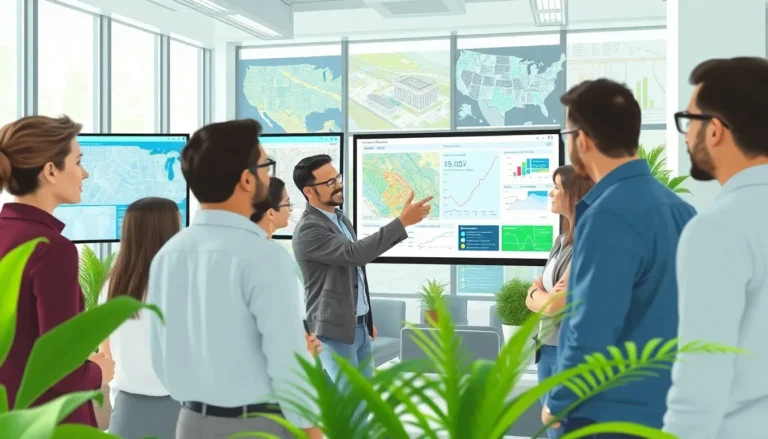Table of Contents
ToggleIn a world where traffic jams feel like a second job and public transport can sometimes resemble a game of sardines, smart infrastructure development is the superhero we never knew we needed. Imagine cities where roads communicate with vehicles and public spaces adapt to citizens’ needs in real-time. It’s not just a futuristic dream—it’s happening right now, and it’s about to change the way we live, work, and play.
As urban populations swell, the demand for innovative solutions grows. Smart infrastructure isn’t just about fancy gadgets; it’s about creating efficient systems that enhance quality of life while tackling issues like congestion, pollution, and energy waste. So buckle up and get ready to explore how these intelligent designs are paving the way for a brighter, more connected future. After all, who wouldn’t want to live in a city that’s as smart as their smartphone?
Overview of Smart Infrastructure Development
Smart infrastructure development represents a significant advancement in urban planning. The integration of technology into public services creates a responsive system that optimizes resource use. Such systems enhance connectivity and accessibility, making everyday experiences smoother for residents.
Innovative transportation solutions evolve from smart infrastructure. Public transit networks use real-time data to improve efficiency and reliability, thus fostering a seamless commute. Cities adopt intelligent traffic management systems that reduce congestion and lower travel times.
Sustainable energy solutions also stem from this development. Smart grids facilitate efficient energy distribution while incorporating renewable sources. These grids enhance energy efficiency, reducing overall waste and minimizing environmental impacts.
Smart infrastructure also prioritizes citizen engagement. Interactive platforms allow residents to provide feedback, enhancing urban development tailored to community needs. Investments in smart public spaces encourage social interaction and community building, thus enhancing quality of life.
Data-driven decision-making supports robust project management in smart infrastructure. Analytics reveal insights into usage patterns and infrastructure performance, allowing for informed investments. Cities benefit from regular assessments that ensure ongoing improvements and sustainability.
As urban areas embrace smart infrastructure, they pave the way for a tech-savvy future. Integrated systems promote a more livable environment through collaborative urban planning. Infrastructure development aligns with modern expectations, addressing challenges and harnessing opportunities in a rapidly evolving world.
Key Components of Smart Infrastructure


Smart infrastructure development hinges on the seamless integration of technology. This technology enhances urban living and improves efficiency across various systems.
Internet of Things (IoT) Integration
IoT integration serves as a backbone for smart infrastructure. Sensors gather real-time data from various sources, allowing cities to monitor traffic flow, energy usage, and environmental conditions. Cities equipped with IoT devices respond to challenges proactively, streamlining public services and reducing response times. Real-time analytics empower officials to make informed decisions quickly. Asset tracking improves maintenance schedules and resource allocation, optimizing overall performance. As such, IoT drives connectivity and enhances the user experience for residents.
Sustainable Materials and Practices
Sustainable materials and practices play a crucial role in smart infrastructure. Utilizing recycled and eco-friendly materials significantly reduces waste and lowers carbon footprints. Sustainable construction methods ensure that buildings consume less energy and water, aligning with environmental goals. Incorporating green roofs and permeable pavements mitigates urban heat and enhances stormwater management. Communities benefit from investing in energy-efficient systems, such as solar panels and LED lighting, that lower long-term costs. Prioritizing sustainability fosters healthier environments while supporting the longevity of urban developments.
Benefits of Smart Infrastructure Development
Smart infrastructure development offers a range of advantages that significantly contribute to urban efficacy and livability. By implementing innovative systems, cities can enhance both functionality and citizen engagement.
Enhanced Efficiency and Connectivity
Enhanced efficiency emerges as a core benefit of smart infrastructure. Smart traffic management systems utilize real-time data to reduce congestion, leading to smoother transportation experiences. Advanced public transit networks, driven by instant feedback from travelers, adapt to demand dynamically. Connectivity improves as cities incorporate IoT devices, allowing for seamless interactions between various urban systems. As devices gather essential data, cities respond swiftly to changes, ultimately delivering faster service to residents. Furthermore, optimized resource allocation results in shorter wait times and increased reliability in public services.
Cost Savings and Long-Term Investments
Cost savings manifest significantly through smart infrastructure deployment. Cities experience reduced operational costs as technology streamlines processes and minimizes waste. Intelligent energy grids, for instance, allow for efficient distribution, lowering energy expenses for both municipalities and citizens. Long-term investments become apparent as cities spend less on emergency repairs and inefficient services. Clear data-driven strategies ensure resources are allocated effectively, maximizing budget impacts. Initial expenditures on smart technologies yield substantial returns over time, fostering economic growth and community well-being.
Challenges in Implementing Smart Infrastructure
Smart infrastructure development faces several persistent challenges, impacting its widespread adoption and effectiveness. Addressing these obstacles is crucial for achieving the envisioned urban transformation.
Technological Barriers
Technological challenges significantly hinder smart infrastructure implementation. Integration of legacy systems with emerging technologies complicates the transition, often resulting in increased costs and extended timelines. Limited interoperability between devices and platforms creates data silos, preventing comprehensive analytics. Additionally, cybersecurity vulnerabilities pose significant risks, threatening the integrity of smart systems. Without robust protection mechanisms, malicious attacks could lead to service disruptions. Training and skill shortages in advanced technologies further exacerbate the situation, making it difficult for personnel to manage and maintain complex smart infrastructure systems.
Regulatory and Policy Issues
Regulatory and policy hurdles present additional challenges for smart infrastructure development. Inconsistent regulations across regions create obstacles for cities seeking to adopt innovative solutions. Compliance with existing laws often limits experimentation and flexibility in technology deployment. Zoning and land-use policies may not align with smart infrastructure initiatives, complicating project approvals. Moreover, a lack of clarity in data ownership and usage rights raises concerns about privacy and ethics. Engaging stakeholders in the policy formulation process becomes essential to ensure regulations support the integration of smart technologies into urban planning effectively.
Case Studies of Successful Smart Infrastructure Projects
Barcelona’s smart lighting system exemplifies advancements in urban efficiency. This project adapts lighting based on real-time data about pedestrian movement and weather conditions, achieving a 30% reduction in energy consumption. The integration of sensors allows the city to enhance safety and reduce costs simultaneously.
Singapore showcases an innovative smart traffic management system that reduces congestion effectively. Advanced algorithms analyze traffic patterns in real-time, rerouting vehicles to decrease travel time by 20%. The system incorporates feedback from IoT devices, enabling dynamic adjustments that respond to changing conditions.
In Masdar City, Abu Dhabi, sustainable energy solutions demonstrate a commitment to environmental responsibility. Utilizing smart grids, this city integrates renewable energy sources and optimizes energy distribution, resulting in a 40% decrease in carbon emissions. The urban design prioritizes energy efficiency, featuring electric transportation and energy-efficient buildings.
The City of Los Angeles implemented an intelligent public transit network to improve accessibility. Real-time GPS tracking enhances the user experience, leading to a 25% increase in ridership. Enhanced communication tools engage residents, providing updates and enabling feedback on service performance.
Amsterdam’s smart water management system represents a proactive approach to resource conservation. Sensors monitor water quality and usage, prompting immediate responses to potential issues. Such measures not only conserve water but also help in maintaining a sustainable urban environment.
These case studies illustrate various approaches to smart infrastructure development, showcasing the potential for enhanced quality of life and environmental responsibility in urban planning. Each project emphasizes the importance of integrating technology into everyday urban operations, thus fostering a more connected and efficient environment.
Future Trends in Smart Infrastructure Development
Emerging technologies are driving the future of smart infrastructure development. Cities are leveraging artificial intelligence and data analytics to enhance urban planning. New advancements in the Internet of Things (IoT) are enabling smarter public services, streamlining processes like traffic management and energy distribution.
Sustainable practices are gaining traction as well. Innovations in construction materials reduce the environmental impact of urban development. Smart grids are becoming standard, integrating renewable energy sources into existing infrastructures. Public transport systems are increasingly adopting real-time data tracking, improving overall efficiency.
Collaboration among governments, tech companies, and citizens is crucial. Engaging the community allows for more tailored solutions to meet local needs. Policymakers must prioritize regulations that foster innovation while ensuring data security and privacy.
Smart infrastructure relies heavily on connectivity. Integrating various systems, such as transportation and utilities, creates a seamless urban experience. Enhancements in mobile technology facilitate better communication between residents and city services.
Investment in smart infrastructure reaps economic benefits. Cost-effective solutions emerge from optimized resource use, leading to long-term savings. Implementing intelligent systems results in better allocation of municipal budgets, freeing up funds for further development.
Collective mobility solutions are on the rise. Electric and autonomous vehicles promise to reduce congestion and emissions, contributing to cleaner air. Furthermore, integrated apps allow users to navigate their cities more efficiently, enhancing overall quality of life.
As urban areas continue to grow, smart infrastructure development remains pivotal. Adopting these trends ensures cities become more livable and resilient, meeting the demands of an ever-evolving population.







